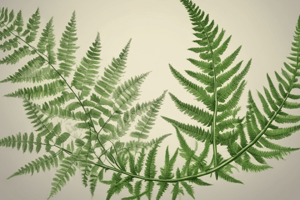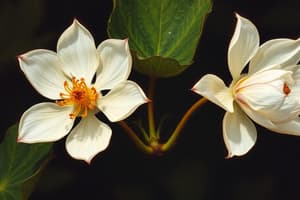Podcast
Questions and Answers
What is the main purpose of the reproductive cycle in flowering plants?
What is the main purpose of the reproductive cycle in flowering plants?
- To give rise to another organism of its kind (correct)
- To create more leaves
- To enhance photosynthesis
- To produce fruits
A microsporocyte undergoes mitosis to produce four haploid microspores.
A microsporocyte undergoes mitosis to produce four haploid microspores.
False (B)
What are the two main phases of the plant life cycle?
What are the two main phases of the plant life cycle?
Diploid phase and Haploid phase
The tissue surrounding the megasporocyte in the ovule is called the ______.
The tissue surrounding the megasporocyte in the ovule is called the ______.
What is formed when one sperm cell unites with the egg cell during double fertilization?
What is formed when one sperm cell unites with the egg cell during double fertilization?
Match the following components of the embryo sac with their descriptions:
Match the following components of the embryo sac with their descriptions:
Epigean germination occurs when the cotyledons remain below soil level.
Epigean germination occurs when the cotyledons remain below soil level.
What is produced as a result of the mitotic division of the generative cell?
What is produced as a result of the mitotic division of the generative cell?
What happens to the synergids and antipodal cells after fertilization?
What happens to the synergids and antipodal cells after fertilization?
Upon landing on a receptive stigma, the pollen grain forms a pollen tube to aid in fertilization.
Upon landing on a receptive stigma, the pollen grain forms a pollen tube to aid in fertilization.
The pollen tube carries the tube nucleus and two __________ cells to the embryo sac.
The pollen tube carries the tube nucleus and two __________ cells to the embryo sac.
The functional megaspore undergoes three successive ______ divisions to form the female gametophyte.
The functional megaspore undergoes three successive ______ divisions to form the female gametophyte.
Which type of pollination involves the transfer of pollen from one plant to another?
Which type of pollination involves the transfer of pollen from one plant to another?
Match the pollination agents with their corresponding types.
Match the pollination agents with their corresponding types.
During pollen tube growth, the tip penetrates the ovule.
During pollen tube growth, the tip penetrates the ovule.
What is the primary function of the endosperm formed during double fertilization?
What is the primary function of the endosperm formed during double fertilization?
Flashcards
Reproductive Cycle of a Plant
Reproductive Cycle of a Plant
A series of events where a plant produces another plant of its own kind.
Diploid Phase (Diplophase)
Diploid Phase (Diplophase)
Phase of a plant's life cycle where all cells have two sets of chromosomes (2n).
Sporophyte
Sporophyte
The plant in the diploid phase that produces spores.
Haploid Phase (Haplophase)
Haploid Phase (Haplophase)
Signup and view all the flashcards
Gametophyte
Gametophyte
Signup and view all the flashcards
Megasporocyte
Megasporocyte
Signup and view all the flashcards
Embryo Sac
Embryo Sac
Signup and view all the flashcards
Pollen Tube Formation
Pollen Tube Formation
Signup and view all the flashcards
Double Fertilization
Double Fertilization
Signup and view all the flashcards
Pollination
Pollination
Signup and view all the flashcards
Sperm Cell Release
Sperm Cell Release
Signup and view all the flashcards
Embryo Development
Embryo Development
Signup and view all the flashcards
Endosperm Formation
Endosperm Formation
Signup and view all the flashcards
Seed Composition
Seed Composition
Signup and view all the flashcards
Cross Pollination
Cross Pollination
Signup and view all the flashcards
Germination
Germination
Signup and view all the flashcards
Study Notes
Plant Life Cycle
- Plant life cycle involves a series of events leading to the creation of a new plant.
- Two main phases exist: diplophase (2n) and haplophase (n).
- Sporophyte (2n): A plant that produces spores (haploid).
- Gametophyte (n): A plant that produces gametes (n).
Flower Reproductive Cycle
- Development of Pollen Grains:
- Microsporocytes (microspore mother cells) form in the anther.
- Meiosis creates four haploid microspores.
- Each microspore undergoes mitosis, forming a generative cell and tube cell.
- The generative cell divides to form two sperm cells.
- Development of Embryo Sac:
- Megasporocyte (megaspore mother cell) develops in the ovule.
- Meiosis produces four haploid megaspores, three degenerate, one survives.
- Mitosis results in the female gametophyte (embryo sac).
- The embryo sac contains synergids, an egg, polar nuclei, and antipodal cells.
Fertilization and Seed Development
- Double Fertilization:
- One sperm fertilizes the egg, creating a diploid zygote (2n).
- The other sperm fuses with polar nuclei, forming a triploid primary endosperm cell (3n).
- Seed Structure:
- Embryo (2n): Develops from the zygote.
- Endosperm (3n): Nutritive tissue, may be consumed by embryo.
- Parts of ovule: Integuments and stored food (cotyledons).
- Pollination: Transfer of pollen grains to receptive stigma, crucial for reproduction.
- Self-pollination: Pollen transferred within the same flower or plant.
- Cross-pollination: Pollen transferred between different plants.
- Agents of Pollination:
- Insects (entomophilous flowers)
- Wind (anemophilous flowers)
- Animals (zoophilous flowers)
- Water (hydrophilous flowers)
- Germination: Resumption of embryonic growth after dispersal.
- Epigeal: Cotyledons lifted above the soil.
- Hypogeal: Cotyledons remain underground.
Studying That Suits You
Use AI to generate personalized quizzes and flashcards to suit your learning preferences.




